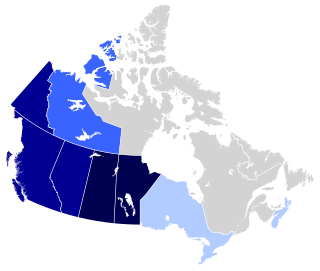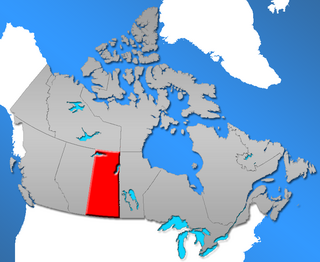Related Research Articles

The University of Manitoba is a Canadian public research university in the province of Manitoba. Founded in 1877, it is the first university of western Canada.

Regina is the capital city of the Canadian province of Saskatchewan. The city is the second-largest in the province, after Saskatoon, and is a commercial centre for southern Saskatchewan. As of the 2021 census, Regina had a city population of 226,404, and a Metropolitan Area population of 249,217. It is governed by Regina City Council. The city is surrounded by the Rural Municipality of Sherwood No. 159.

The University of Saskatchewan is a Canadian public research university, founded on March 19, 1907, and located on the east side of the South Saskatchewan River in Saskatoon, Saskatchewan, Canada. An "Act to establish and incorporate a University for the Province of Saskatchewan" was passed by the provincial legislature in 1907. It established the provincial university on March 19, 1907 "for the purpose of providing facilities for higher education in all its branches and enabling all persons without regard to race, creed or religion to take the fullest advantage". The University of Saskatchewan is the largest education institution in the Canadian province of Saskatchewan. The University of Saskatchewan is one of Canada's top research universities and is a member of the U15 Group of Canadian Research Universities.

The University of Regina is a public research university located in Regina, Saskatchewan, Canada. Founded in 1911 as a private denominational high school of the Methodist Church of Canada, it began an association with the University of Saskatchewan as a junior college in 1925, and was disaffiliated by the Church and fully ceded to the university in 1934; in 1961 it attained degree-granting status as the Regina Campus of the University of Saskatchewan. It became an autonomous university in 1974. The University of Regina has an enrolment of over 15,000 full and part-time students. The university's student newspaper, The Carillon, is a member of CUP.

The University of Winnipeg is a public research university in Winnipeg, Manitoba, Canada. It offers undergraduate programs in art, business, economics, education, science and applied health as well as graduate programs. UWinnipeg's founding colleges were Manitoba College and Wesley College, which merged to form United College in 1938. The University of Winnipeg was established in 1967 when United College received its charter.

St. Thomas More College (STM) is a Catholic, undergraduate, liberal arts college located in Saskatoon, Saskatchewan, Canada, and is a federated college of the University of Saskatchewan.

Ukrainian Canadians are Canadian citizens of Ukrainian descent or Ukrainian-born people who immigrated to Canada.
St. Mary’s University is a private Catholic university in Calgary, Alberta. A teaching and research university, St. Mary's is accredited by Alberta Advanced Education as an "Independent Academic Institution" and offers degrees in the liberal arts, sciences and education. The university has 1025 full-time students, 80 full-time and part-time faculty, and an average class size of 25.

Grenfell is a town in Southern Saskatchewan, Canada. It is situated at the junction of Highway 47 and the Trans-Canada Highway 1 80 miles (130 km) east of Regina, the provincial capital. It is 15 miles (24 km) south of the Qu'Appelle Valley where Crooked Lake Provincial Park and Bird's Point Resort are popular beach destinations in summer and are accessed by Highway 47.

Canora is a town, located at the junction of highways No. 5 and 9 in east central Saskatchewan, about 50 km north of Yorkton. It is centrally located on the corners of four adjacent rural municipalities, including the RM of Good Lake. The community is home to approximately 3,500 residents and is part of the Canora-Pelly electoral district. The community was founded along the Canadian Northern Railway tracks - one of the companies that evolved into the Canadian National Railway (CN), and two CN freight lines still run through Canora. The Canora railway station, downtown on the CN east-west line before the switch to the northbound line, is served by Via Rail on its passenger service from Winnipeg to Churchill, Manitoba. As of 2016, 53% of the town’s residents are either from Ukraine or of Ukrainian descent, with the language still widely spoken in the community.

Maple Creek is a town in the Cypress Hills of southwest Saskatchewan, Canada. It is surrounded by the Rural Municipality of Maple Creek No. 111. The population was 2,176 at the 2021 Census.

University of Saskatchewan has over 200 academic programs on its Saskatoon, Saskatchewan campus, and is internationally known for its teaching and research. The on-campus synchrotron Canadian Light Source makes it the only Canadian institution for such nuclear and biotechnology research. Canadian Light Source nuclear research facility provides research and analysis of the internal structures of advanced materials and biological samples. The College of Arts and Science is the largest of the U of S and comprises five separate health science fields in addition to numerous other programs in the Arts, Social Sciences, Humanities, and Natural Sciences. The Department of Computer Science as well as the College of Engineering are ranked highly within their fields. The founding college, the College of Agriculture, is still providing agricultural breakthroughs which are utilized worldwide.

Girvin is a former village of 20 people in Saskatchewan, Canada. It is located midway between Regina and Saskatoon on Highway 11 between the towns of Davidson and Craik. The village was formally dissolved in 2005; its remaining population is now counted as part of the rural municipality of Arm River.
The Federation of Sovereign Indigenous Nations (FSIN), formerly known as the Federation of Saskatchewan Indian Nations, is a Saskatchewan-based First Nations organization. It represents 74 First Nations in Saskatchewan and is committed to honouring the spirit and intent of the Numbered Treaties, as well as the promotion, protection and implementation of these promises made over a century ago.

Higher education in Canada includes provincial, territorial, indigenous and military higher education systems. The goal of Canadian higher education is to give every Canadian the chance to gain the skills and knowledge they need to reach their fullest potential. It builds a world-class workforce, increases the number of Canadians working, and secures Canada's long-term prosperity. Higher education programs are crafted from the employee's viewpoint in mind, aiming to minimize risks and providing guaranteed outcomes.

Historically, Saskatchewan's higher education system has been "significantly shaped" by demographics. In 1901, six years prior to the 1907 founding of a university in Saskatchewan, the urban population in Saskatchewan was 14,266 (16%) while the rural population was 77,013 (84%). One hundred years later, the proportions had changed significantly: urban population in 2001 was 629,036 (64%) while the rural population was 349,897 (36%). Over time the province's higher education system has changed significantly in response both to this demographic shift and to provincial politics.

Eaton Internment Camp, although short-lived, was one of twenty-four official internment facilities created in Canada to accommodate prisoners of war during the period from 1914 to 1920. It was the only facility of its kind in the province of Saskatchewan.

Eston College is a private Christian post-secondary educational institution located in Regina, Saskatchewan, Canada. Since 1944 it has served as the primary training center for the Apostolic Church of Pentecost (ACOP).
Tania Miller is a Canadian conductor.
References
- ↑ "On Campus News". www.usask.ca. Archived from the original on 2000-04-13.
- ↑ http://esask.uregina.ca/entry/ukrainian_language_teaching.html Archived 2007-09-13 at the Wayback Machine ; and http://www.encyclopediaofukraine.com/pages/S/A/Saskatchewan.htm
- ↑ http://www.ucc.sk.ca/about.htm Archived 2011-02-27 at the Wayback Machine ; and "Ukrainian Canadian Congress: Congress XXI -- Round Table No. 3: Education -- Àíäð³é Ãëàäèøåâñüêèé / Andrew Hladyshevsky". Archived from the original on 2007-02-22. Retrieved 2009-01-30.
- ↑ Ukrainian Weekly, "Prairie Center Embarks on Campaign to Endow Diverse Academic Programs", Vol. 69, No.7, February 18, 2001
- ↑ Ukrainian Weekly, "Saskatchewan Government Report Lauds Prairie Center's Role as Community Link", Vol. 70, No. 2, January 13, 2002